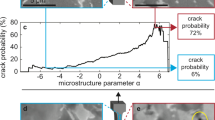Abstract
A model is presented that establishes a quantitative relationship between the J IC and the J-R curve and the microstructural parameters, such as inclusion size and spacing, and the plastic deformation properties of ductile materials, such as yield strength and strain hardening exponents. The model assumes that ductile crack growth occurs by void nucleation, growth, and coalescence. Each of these processes is modeled in the crack tip environment to complete the model. The proposed model is evaluated using tests performed on 303 stainless steel (SS) at room temperature and on 1Cr-Mo-0.25V steel at 565 °C. Satisfactory agreements are obtained between the experimentally obtained J-R curves and those predicted from the model. Limitations of the model are also discussed.
Similar content being viewed by others
References
J.A. Begley and J.D. Landes: “The J-Integral as a Fracture Criterion, Fracture Toughness,” ASTM STP 514, ASTM, Philadelphia, PA, pp. 1–23.
“Standard Test Method for Determining J-R Curves,” ASTM Standard E-1152, Annual Book of ASTM Standards, 1992, vol. 03.01, pp. 847-57.
A. Saxena, D.C. Daly, H.A. Ernst, and K. Banerji: “Microscopic Aspects of Ductile Tearing Resistance in AISI 303 Stainless Steel,” Fracture Mechanics: 21st Symp., ASTM STP 1074, ASTM, Philadelphia, PA, 1990, pp. 378–95.
A.S. Argon, J. Im, and R. Sofoglu: Metall. Trans. A, 1975, vol. 6A, pp. 825–37.
J.R. Rice and D.M. Tracey: J. Mech. Phys. Solids, 1969, vol. 17, pp. 201–17.
J.W. Hutchinson and P.C. Paris: “Stability Analysis of J-Controlled Crack Growth, Elastic-Plastic Fracture,” ASTM STP 668, ASTM, Philadelphia, PA, 1979, pp. 37–64.
J.W. Hutchinson: J. Mech. Phys. Solids, 1968, vol. 16, pp. 337–47.
J.R. Rice and G.F. Rosengren: J. Mech. Phys. Solids, 1968, vol. 16, pp. 1–12.
C.F. Shih: “Tables of Hutchinson-Rice-Rosengren Singular Field Quantities,” MRL E-147, Brown University, Providence, RI.
N.P. O’Dowd and C.F. Shih: “Two-Parameter Fracture Mechanics: Theory and Applications,” Fracture Mechanics: Twenty Fourth Volume, ASTM STP 1207, ASTM, Philadelphia, PA, 1994, pp. 21–47.
“Standard Test Methods of Tension Testing of Metallic Materials,” ASTM Standard E-8, Annual Book of ASTM Standards, ASTM, Philadelphia, PA, 1992, vol. 03.01, pp. 130–68.
E.E. Underwood: Quantitative Stereology, Addison-Wesley, Reading, MA, 1970.
“Standard Test Method for J IC , A Measure of Fracture Toughness,” ASTM Standard E-813, Annual Book of ASTM Standards, ASTM, Philadelphia, PA, 1996, vol. 03.01, pp. 633–47.
Author information
Authors and Affiliations
Rights and permissions
About this article
Cite this article
Saxena, A., Cretegny, L. The relationship between microstructure and the J-R curve. Metall Mater Trans A 29, 1917–1922 (1998). https://doi.org/10.1007/s11661-998-0016-2
Received:
Issue Date:
DOI: https://doi.org/10.1007/s11661-998-0016-2




